
Coma Berenices is an ancient asterism in the northern sky, which has been defined as one of the 88 modern constellations. It is in the direction of the fourth galactic quadrant, between Leo and Boötes, and it is visible in both hemispheres. Its name means "Berenice's Hair" in Latin and refers to Queen Berenice II of Egypt, who sacrificed her long hair as a votive offering. It was introduced to Western astronomy during the third century BC by Conon of Samos and was further corroborated as a constellation by Gerardus Mercator and Tycho Brahe. It is the only modern constellation named after a historic person.

The Pinwheel Galaxy is a face-on, unbarred, and counterclockwise spiral galaxy located 21 million light-years from Earth in the constellation Ursa Major. It was discovered by Pierre Méchain in 1781 and was communicated that year to Charles Messier, who verified its position for inclusion in the Messier Catalogue as one of its final entries.
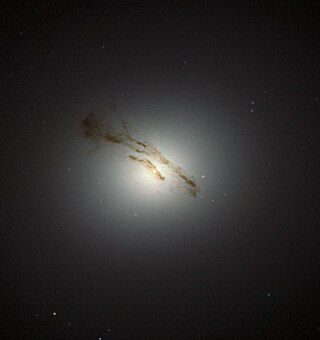
Messier 84 or M84, also known as NGC 4374, is a giant elliptical or lenticular galaxy in the constellation Virgo. Charles Messier discovered the object in 1781 in a systematic search for "nebulous objects" in the night sky. It is the 84th object in the Messier Catalogue and in the heavily populated core of the Virgo Cluster of galaxies, part of the local supercluster.
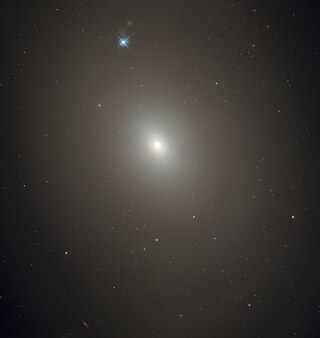
Messier 85 is a lenticular galaxy, or elliptical galaxy for other authors, in the Coma Berenices constellation. It is 60 million light-years away, and has a diameter of about 36.99 kiloparsecs across.

Messier 99 or M99, also known as NGC 4254 or St. Catherine's Wheel, is a grand design spiral galaxy in the northern constellation Coma Berenices approximately 15,000,000 parsecs from the Milky Way. It was discovered by Pierre Méchain on 17 March 1781. The discovery was then reported to Charles Messier, who included the object in the Messier Catalogue of comet-like objects. It was one of the first galaxies in which a spiral pattern was seen. This pattern was first identified by Lord Rosse in the spring of 1846.

NGC 4725 is an intermediate barred spiral galaxy with a prominent ring structure, located in the northern constellation of Coma Berenices near the north galactic pole. It was discovered by German-born British astronomer William Herschel on April 6, 1785. The galaxy lies at a distance of approximately 40 megalight-years from the Milky Way. NGC 4725 is the brightest member of the Coma I Group of the Coma-Sculptor Cloud, although it is relatively isolated from the other members of this group. This galaxy is strongly disturbed and is interacting with neighboring spiral galaxy NGC 4747, with its spiral arms showing indications of warping. The pair have an angular separation of 24′, which corresponds to a projected linear separation of 370 kly. A tidal plume extends from NGC 4747 toward NGC 4725.
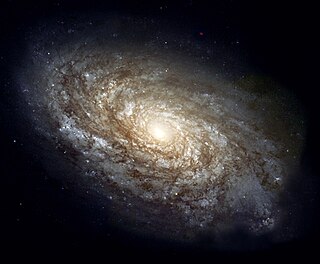
NGC 4414, also known as the Dusty Spiral Galaxy, is an unbarred spiral galaxy about 62 million light-years away in the constellation Coma Berenices. It was discovered by German-British astronomer William Herschel on 13 March 1785.
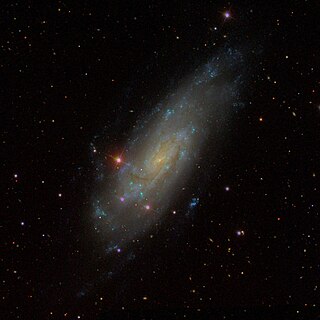
NGC 4559 is an intermediate spiral galaxy with a weak inner ring structure in the constellation Coma Berenices. Distance estimates for NGC 4559 range from about 28 million light-years to 31 million light-years, averaging about 29 million light-years. It was discovered on 11 April 1785 by German-British astronomer William Herschel.

NGC 4921 is a large barred spiral galaxy in the Coma Cluster, located in the constellation Coma Berenices. It was discovered by German-British astronomer William Herschel on 11 April 1785. It is about 320 million light-years from Earth. The galaxy has a nucleus with a bar structure that is surrounded by a distinct ring of dust that contains recently formed, hot blue stars. The outer part consists of unusually smooth, poorly distinguished spiral arms.
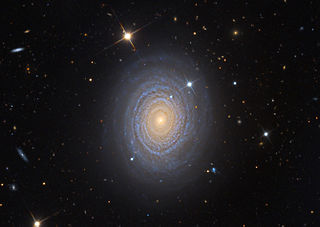
NGC 488 is a face-on spiral galaxy in the constellation Pisces. It was discovered by German-British astronomer William Herschel on 13 December 1784. It is at a distance of about 90 million light-years away from Earth. Its diameter is estimated to be 52,6 Kpc. The galaxy has a large central bulge, and is considered a prototype galaxy with multiple spiral arms. Its arms are tightly wound. Star forming activity has been traced within the arms. The nucleus of NGC 488 has been found to be chemically decoupled, being twice as metal rich as the central bulge of the galaxy. NGC 488, with the exception of its smaller companions, that form NGC 488 group, is an isolated galaxy.
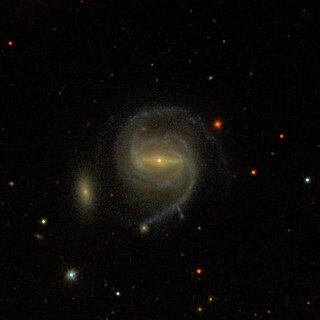
NGC 5000 is a barred spiral galaxy in the constellation Coma Berenices. It was discovered by William Herschel in 1785. It is also known as LEDA 45658, MCG+05-31-144, UGC 8241, VV 460, III 366, h 1544, and GC 3433.
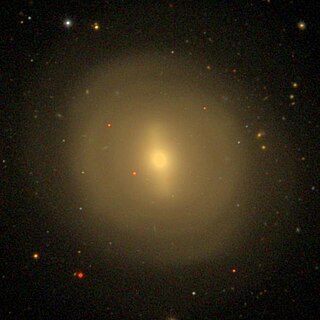
NGC 4477 is a barred lenticular galaxy located about 55 million light-years away in the constellation of Coma Berenices. NGC 4477 is classified as a type 2 Seyfert galaxy. The galaxy was discovered by astronomer William Herschel on April 8, 1784. NGC 4477 is a member of Markarian's Chain which forms part of the larger Virgo Cluster.

NGC 4340 is a double-barred lenticular galaxy located about 55 million light-years away in the constellation of Coma Berenices. NGC 4340 was discovered by astronomer William Herschel on March 21, 1784. NGC 4340 is a member of the Virgo Cluster. NGC 4340 is generally thought to be in a pair with the galaxy NGC 4350.

NGC 4873 is a lenticular galaxy located about 270 million light-years away in the constellation of Coma Berenices. NGC 4873 was discovered by astronomer Heinrich d'Arrest on May 10, 1863. The galaxy is a member of the Coma Cluster.
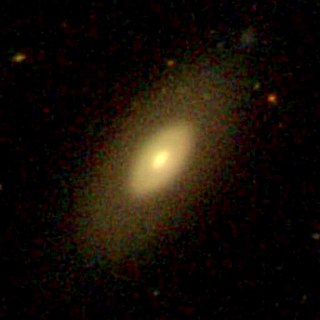
NGC 4919 is a lenticular galaxy located about 340 million light-years away in the constellation of Coma Berenices. NGC 4919 was discovered by astronomer Heinrich d'Arrest on May 5, 1864. NGC 4919 is a member of the Coma Cluster.

NGC 4479 is a barred lenticular galaxy located about 60 million light-years away in the constellation of Coma Berenices. NGC 4479 was discovered by astronomer William Herschel on April 8, 1784. It is a member of the Virgo Cluster.

NGC 4474 is an edge-on lenticular galaxy located about 50 million light-years away in the constellation Coma Berenices. NGC 4474 was discovered by astronomer William Herschel on April 8, 1784. It is a member of the Virgo Cluster.

NGC 2300 is a lenticular galaxy in the constellation Cepheus. Its velocity with respect to the cosmic microwave background is 1876 ± 7 km/s, which corresponds to a Hubble distance of 90.2 ± 6.3 Mly (27.67 ± 1.94 Mpc). However, 11 non redshift measurements give a distance of 131.98 ± 21.75 Mly (40.464 ± 6.668 Mpc). The galaxy was discovered in 1871 by French astronomer Alphonse Borrelly using an 18 cm telescope.
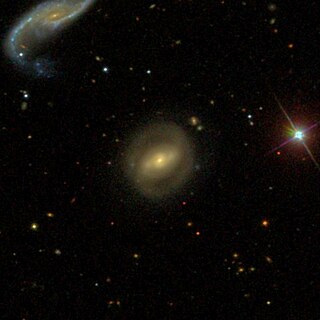
NGC 4614 is a barred lenticular galaxy in the New General Catalog. It is located in the constellation of Coma Berenices. It was discovered in 1864 by the German astronomer Heinrich d'Arrest with a 11.9 inch diameter lens type telescope.

NGC 4680 is a spiral/lenticular galaxy in the constellation Virgo. It is estimated to be 106 million light-years from the Milky Way and has a diameter of about 45,000 ly. In the same area of the sky there are, among other things: the galaxies NGC 4700 and NGC 4708. NGC 4680 was discovered on May 27, 1835, by John Herschel using an 18-inch reflecting telescope, who described it as "eF, S, has one or two small stars entangled in it".




















